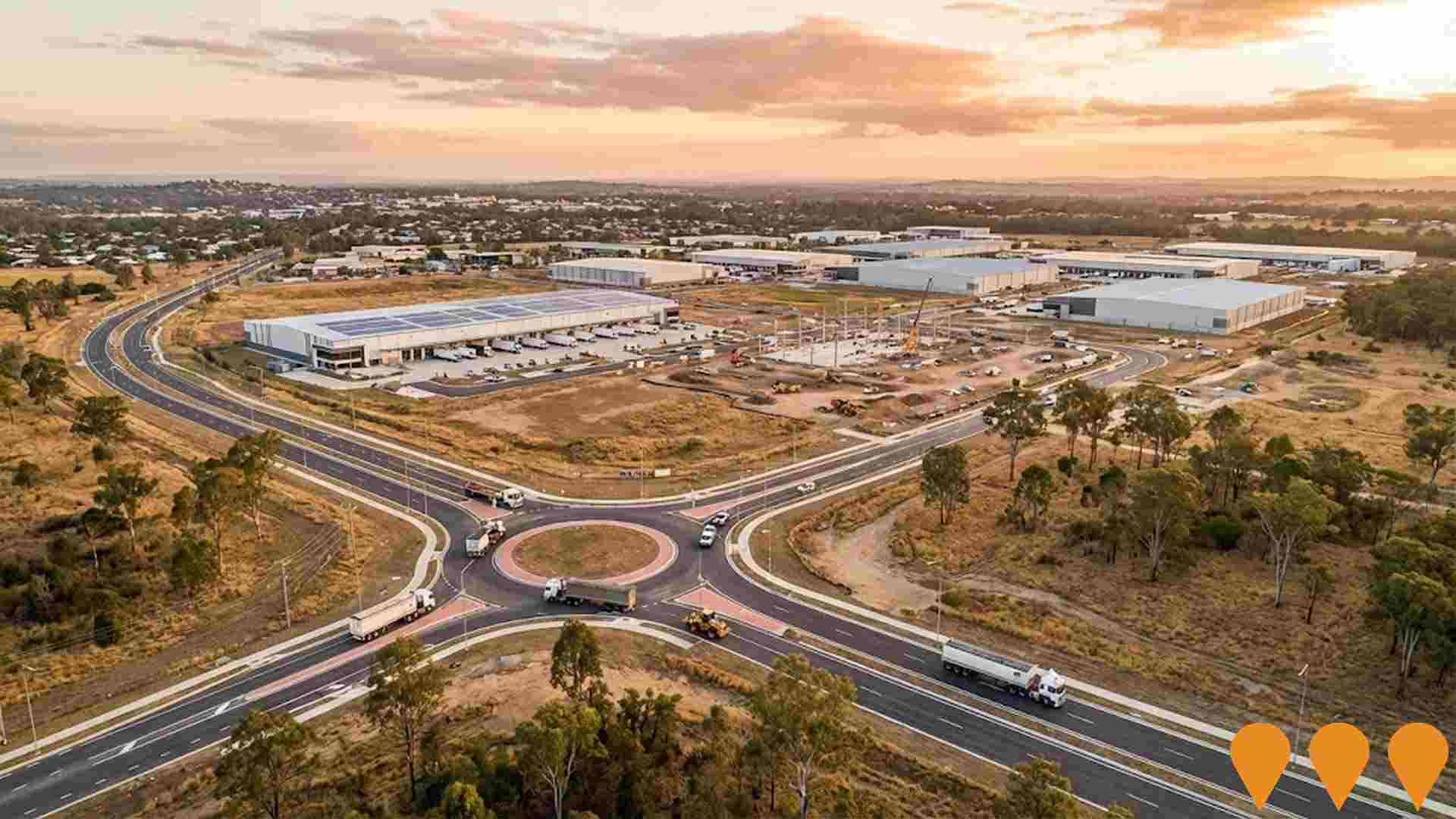Chart Color Schemes
est. as @ -- *
ABS ERP | -- people | --
2021 Census | -- people
Sales Activity
Curious about local property values? Filter the chart to assess the volume and appreciation (including resales) trends and regional comparisons, or scroll to the map below view this information at an individual property level.
Find a Recent Sale
Sales Detail
Population
Karalee - Barellan Point lies within the top quartile of areas nationally for population growth performance according to AreaSearch analysis of recent, and medium to long-term trends
Karalee-Barellan Point's population was 6,694 as of the 2021 Census. By Nov 2025, it is estimated to be around 7,257, an increase of 563 people (8.4%). This growth is inferred from ABS data showing an estimated resident population of 7,212 in June 2024 and the addition of 38 validated new addresses since the Census date. The population density is approximately 377 persons per square kilometer. Over the past decade, ending in 2021, Karalee-Barellan Point has shown resilient growth with a compound annual growth rate of 3.0%, outperforming its SA3 area. Interstate migration contributed about 46.6% of overall population gains during recent periods.
AreaSearch uses ABS/Geoscience Australia projections for each SA2 area released in 2024, based on 2022 data. For areas not covered by this data and years post-2032, Queensland State Government's SA2 area projections from 2023, based on 2021 data, are adopted. These state projections lack age category splits, so AreaSearch applies proportional growth weightings in line with ABS Greater Capital Region projections released in 2023, based on 2022 data. Future population trends project above median growth for Australian statistical areas. By 2041, Karalee-Barellan Point is expected to expand by 1,171 persons, recording a total gain of 15.5% over the 17 years.
Frequently Asked Questions - Population
Development
Recent residential development output has been above average within Karalee - Barellan Point when compared nationally
Karalee - Barellan Point averaged approximately 33 new dwelling approvals annually between FY-21 and FY-25, with a total of 168 homes approved during this period. In FY-26, 13 dwellings have been approved so far.
Over the past five financial years, an average of 6.2 new residents arrived per year for each dwelling constructed. This significant demand outpaces new supply, typically leading to price growth and heightened buyer competition. The average construction cost of new properties is $220,000, below the regional average, indicating more affordable housing options. Compared to Greater Brisbane, Karalee - Barellan Point has notably less development activity, with 56.0% fewer approvals per person than the regional average.
This scarcity of new homes often bolsters demand and prices for existing properties. Recent building activity comprises solely standalone homes, preserving the area's traditional low-density character and appealing to families seeking spacious housing options. The estimated population density is 386 people per dwelling approval, reflecting Karalee - Barellan Point's quiet development environment. Population forecasts project an increase of 1,126 residents by 2041. Based on current development patterns, new housing supply should comfortably meet demand, presenting favorable conditions for buyers and potentially facilitating population growth beyond current projections.
Frequently Asked Questions - Development
Infrastructure
Karalee - Barellan Point has strong levels of nearby infrastructure activity, ranking in the top 30% nationally
Changes to local infrastructure significantly influence an area's performance. AreaSearch has identified three projects that may impact this region. Major projects include the Warrego Highway - Mount Crosby Road Interchange Upgrade, Citiswich Business Park Expansion, Bundamba Industrial Precinct Expansion, and Woodlinks Village. The following details those most relevant.
Professional plan users can use the search below to filter and access additional projects.
INFRASTRUCTURE SEARCH
 Denotes AI-based impression for illustrative purposes only, not to be taken as definitive under any circumstances. Please follow links and conduct other investigations from the project's source for actual imagery. Developers and project owners wishing us to use original imagery please Contact Us and we will do so.
Denotes AI-based impression for illustrative purposes only, not to be taken as definitive under any circumstances. Please follow links and conduct other investigations from the project's source for actual imagery. Developers and project owners wishing us to use original imagery please Contact Us and we will do so.
Frequently Asked Questions - Infrastructure
Ipswich Better Bus Network
Multi-stage bus network improvement program for Ipswich delivering new routes, higher frequencies, extended hours, and bus priority measures. Focuses on connecting growth areas including Redbank Plains, Springfield, Ripley, Augustine Heights, Bellbird Park, Collingwood Park, and Karalee. Includes new bus rapid transit elements, station upgrades, real-time passenger information, and integration with Cross River Rail and future Ipswich to Springfield public transport corridor.
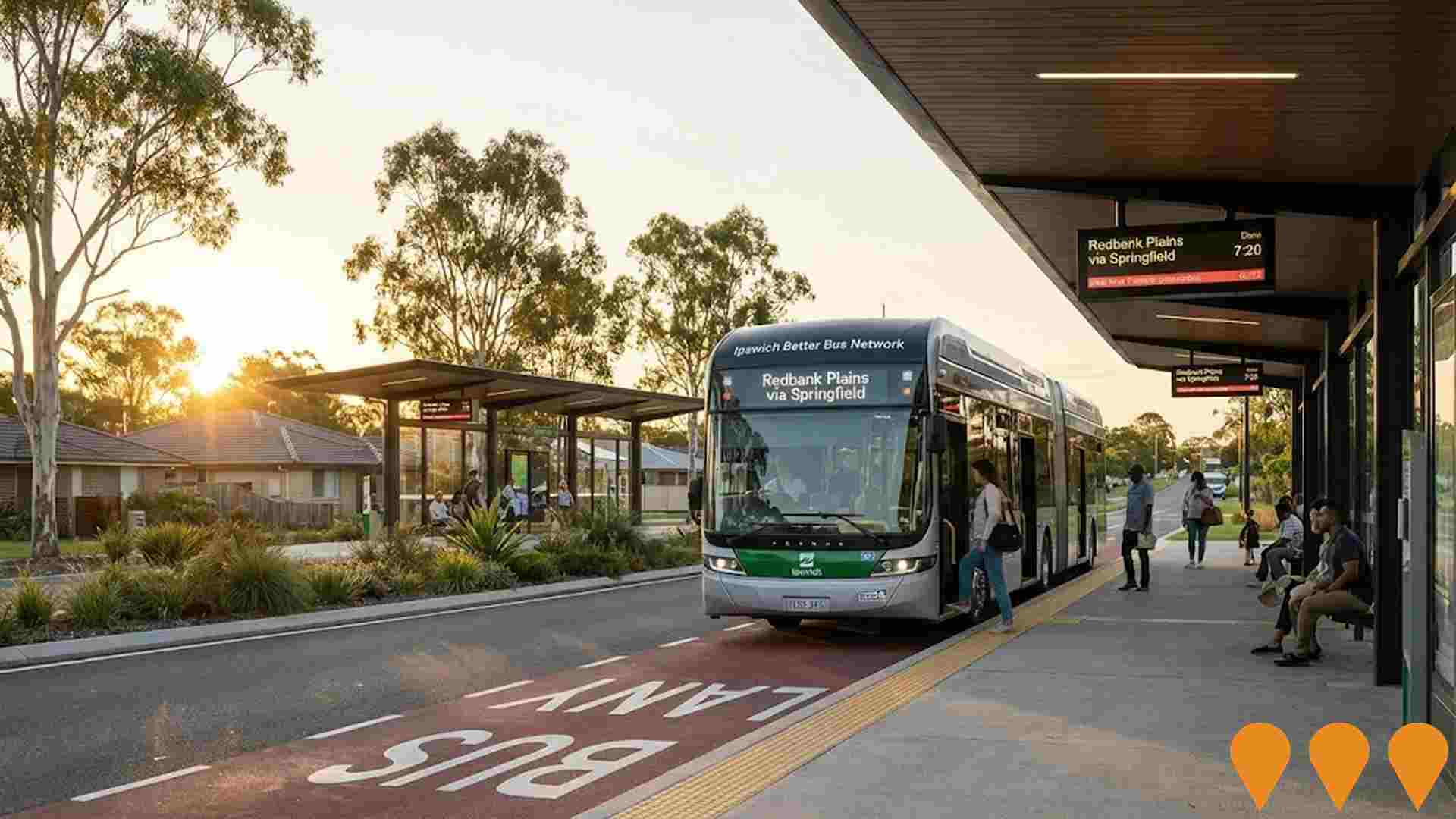
Ipswich to Springfield Central Public Transport Corridor (I2S)
The Ipswich to Springfield Central Public Transport Corridor (I2S) is a proposed 25 km dedicated mass transit corridor linking Ipswich Central and Springfield Central via Ripley and Redbank Plains. The project includes nine new stations and will support future growth in one of South East Queenslands fastest-growing regions. The Options Analysis was completed in late 2024. A Detailed Business Case, jointly funded by the Australian Government, Queensland Government and Ipswich City Council under the South East Queensland City Deal, is scheduled to commence in 2026. Delivery mode (heavy rail, trackless tram or other) and final alignment are still under investigation.

Ipswich Smart City Program
The Ipswich Smart City Program is a city-wide digital transformation initiative led by Ipswich City Council to enhance liveability, sustainability and economic prosperity through smart technology. Key components include IoT sensors, smart lighting, public Wi-Fi, environmental monitoring, a city data platform and multiple pilot precincts. The program remains active with ongoing rollout of new sensors, smart parking and flood-monitoring projects across the city as of 2025.
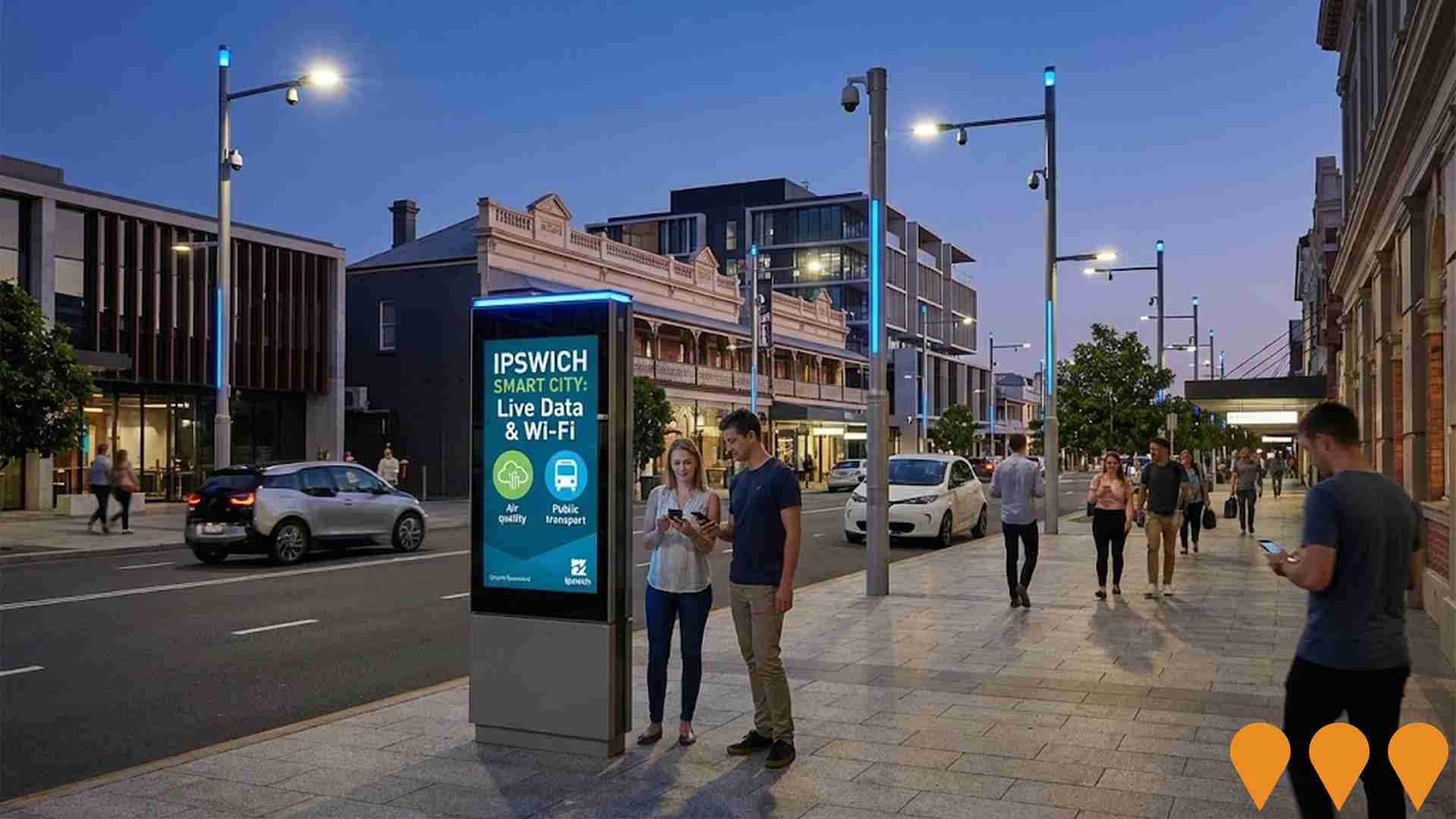
Centenary Motorway Upgrade Planning
The Queensland Department of Transport and Main Roads is developing a long-term corridor masterplan for the upgrade of the Centenary Motorway between Darra and Toowong. Two shortlisted options: Option 1 - a tunnel with targeted surface upgrades; Option 2 - widening of the existing motorway plus a new arterial road. The motorway serves high daily traffic volumes with significant forecasted growth. Masterplan finalisation expected in 2025, with community consultation on options in early-mid 2025. Upgrades to be delivered in stages subject to future funding. Separate to the ongoing Centenary Bridge Upgrade at Jindalee. Planning funded by $10 million from the Australian Government.
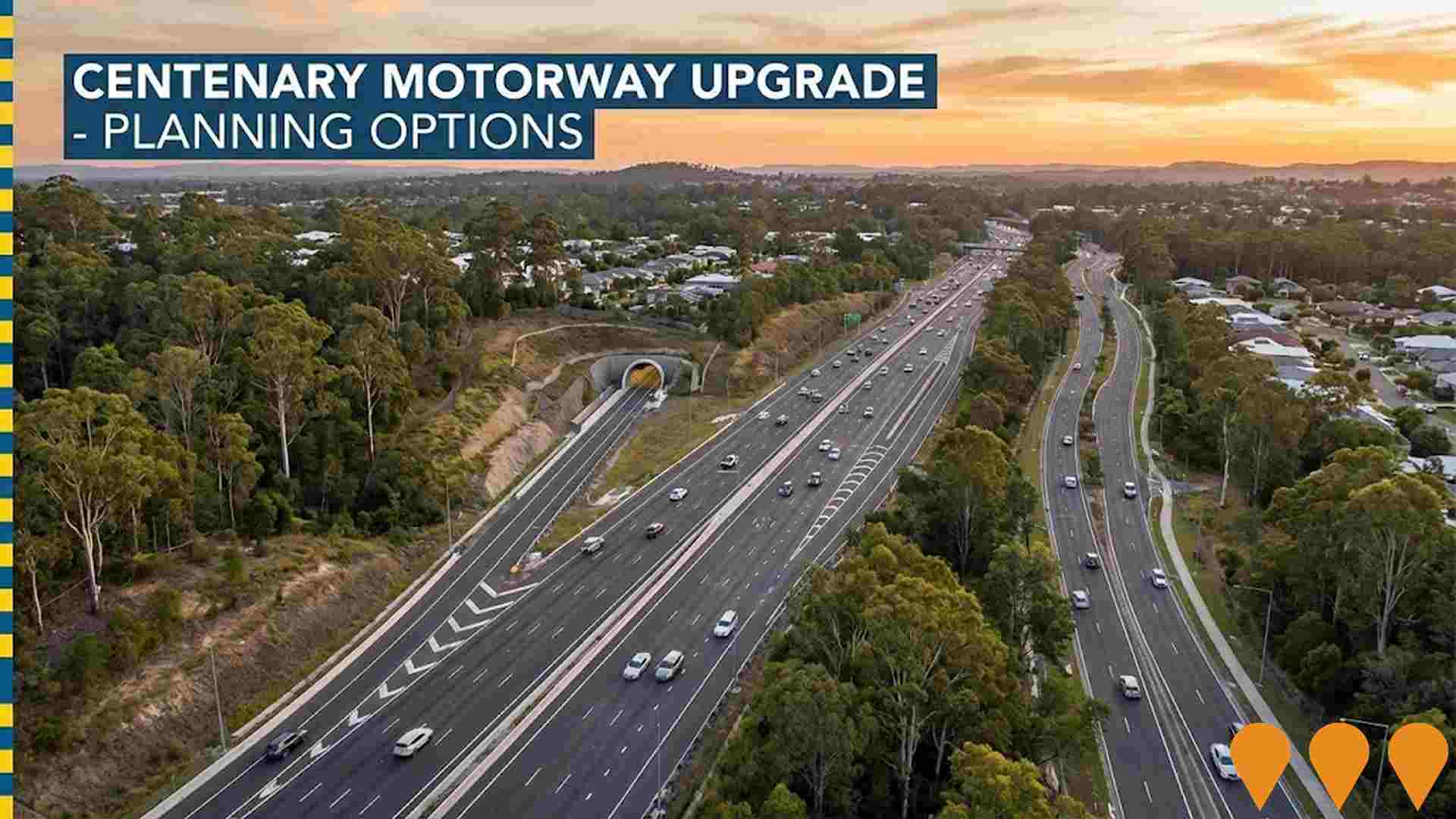
Ipswich AOD Residential Rehabilitation Facility (West Moreton Recovery)
A state-of-the-art 46-bed residential treatment facility providing voluntary rehabilitation and withdrawal services for adults with alcohol and other drug issues. The facility includes 36 residential rehabilitation beds and a 10-bed withdrawal (detox) unit. Operated by Lives Lived Well under contract with Queensland Health, the service will be staffed 24/7 with experienced qualified staff. The facility sits on 1.9 hectares and will create approximately 25 new full-time jobs when operational. Construction commenced in September 2024 and is approaching completion with service opening expected in late 2025.
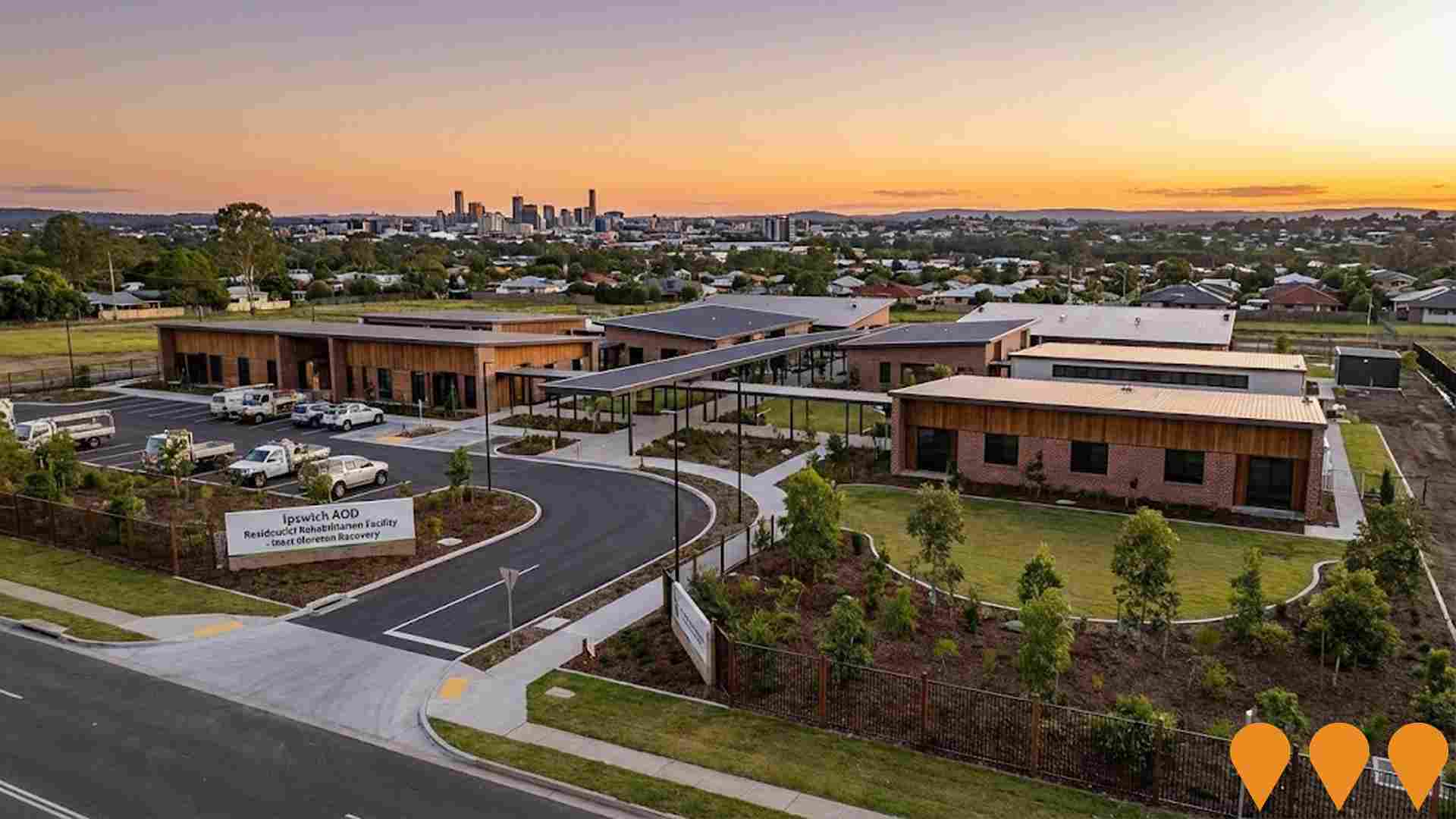
Woodlinks Village
Master-planned community spanning 78 hectares with 900 allotments, featuring over 30% dedicated to parklands and open spaces. The development includes a 5,000 sqm community park with playground, basketball court, and picnic areas, pedestrian walkways, and cyclepaths along rehabilitated Goodna Creek. Located within walking distance of WoodLinks State School and Woolworths Marketplace, offering affordable fixed-price homes with various block sizes.

Warrego Highway - Mount Crosby Road Interchange Upgrade
Upgrade of the Warrego Highway and Mount Crosby Road interchange to alleviate congestion and reduce traffic incidents. The project includes a new interchange and a new dual-lane bridge to improve safety, capacity, and efficiency on this critical transport corridor.
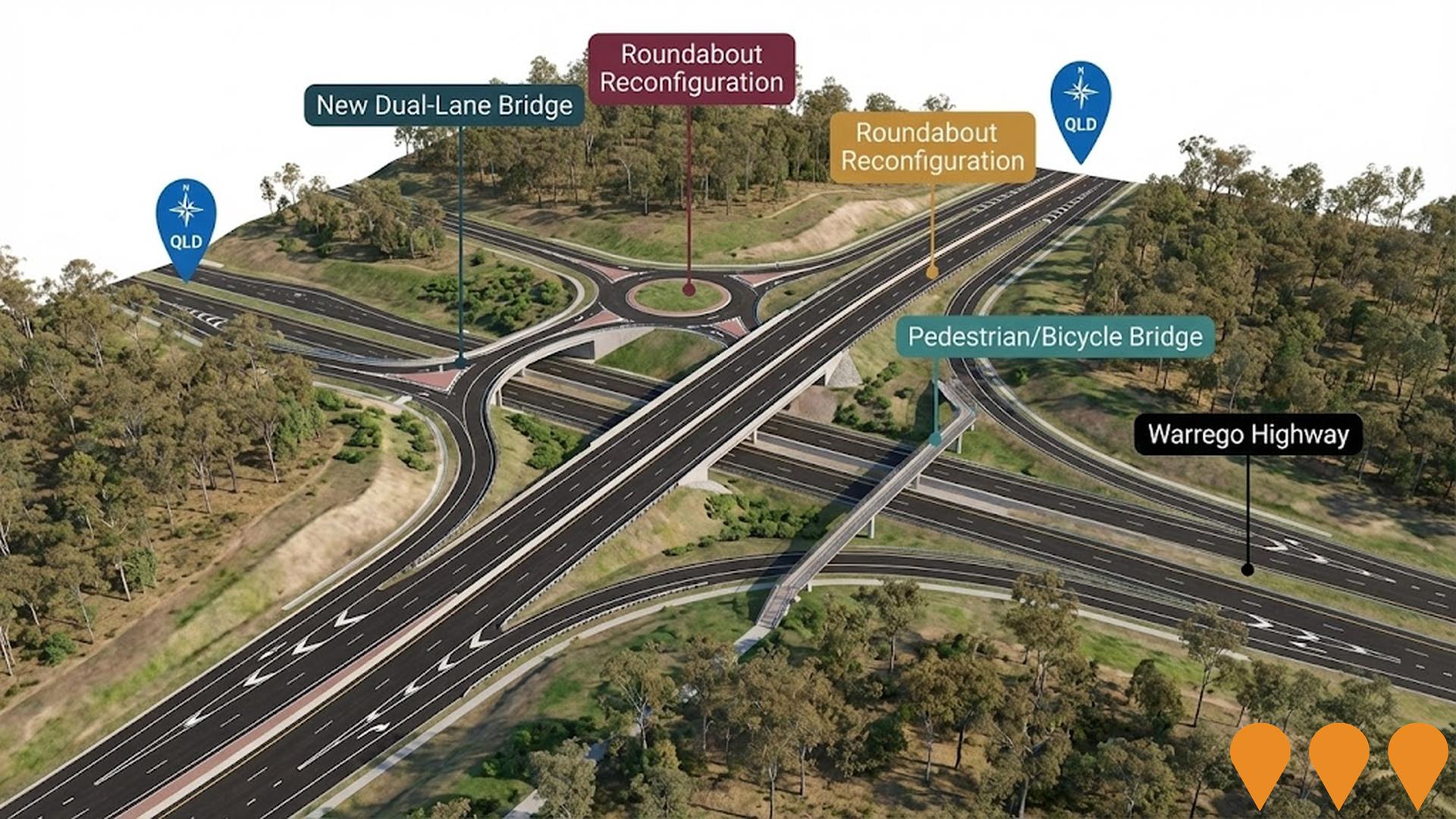
Citiswich Business Park Expansion
Expansion of Citiswich Business Park providing additional commercial and industrial space. Strategic employment hub supporting western Brisbane corridor economic development with modern facilities and transport connectivity.

Employment
AreaSearch analysis of employment trends sees Karalee - Barellan Point performing better than 90% of local markets assessed across Australia
Karalee - Barellan Point has a skilled workforce with 4,145 residents employed as of June 2025. The unemployment rate is 1.8%.
Over the past year, employment levels increased by 0.1% and labour force grew by 0.3%, resulting in an unemployment rise of 0.2 percentage points. Leading employment industries are health care & social assistance, education & training, and construction. Public administration & safety has notable concentration with employment levels at 1.5 times the regional average. Professional & technical services have limited presence at 6.6% compared to the regional average of 8.9%.
The area's workforce participation rate is 72.0%, higher than Greater Brisbane's 64.5%. The unemployment rate is 2.3% lower than Greater Brisbane's rate of 4.1%. Jobs and Skills Australia forecasts national employment growth of 6.6% over five years and 13.7% over ten years. Applying these projections to Karalee - Barellan Point's employment mix suggests local growth of approximately 6.3% over five years and 13.2% over ten years.
Frequently Asked Questions - Employment
Income
Income metrics indicate excellent economic conditions, with the area achieving higher performance than 75% of national locations assessed by AreaSearch
AreaSearch's latest postcode level ATO data for financial year 2022 shows Karalee - Barellan Point's median income among taxpayers is $59,230. The average income in the area is $67,671. This is above the national average. In comparison, Greater Brisbane has a median income of $55,645 and an average income of $70,520. Based on Wage Price Index growth of 13.99% since financial year 2022, current estimates for Karalee - Barellan Point would be approximately $67,516 (median) and $77,138 (average) as of September 2025. According to the 2021 Census, household, family, and personal incomes in Karalee - Barellan Point rank highly nationally, between the 80th and 90th percentiles. The earnings profile shows that 33.8% of locals (2,452 people) fall into the $1,500 - 2,999 income category. This aligns with the surrounding region where this cohort also represents 33.3%. Economic strength is evident through 37.9% of households achieving high weekly earnings exceeding $3,000, supporting elevated consumer spending. After housing costs, residents retain 86.7% of their income, reflecting strong purchasing power. The area's SEIFA income ranking places it in the 7th decile.
Frequently Asked Questions - Income
Housing
Karalee - Barellan Point is characterized by a predominantly suburban housing profile, with above-average rates of outright home ownership
Karalee-Barellan Point's dwellings, as per the latest Census, were 98.5% houses and 1.5% other types (semi-detached, apartments, 'other' dwellings), compared to Brisbane metro's 88.4% houses and 11.6% others. Home ownership in Karalee-Barellan Point was 28.2%, with mortgaged dwellings at 59.0% and rented at 12.8%. The median monthly mortgage repayment was $2,057, higher than Brisbane metro's $1,517. Median weekly rent was $400, compared to Brisbane metro's $300. Nationally, Karalee-Barellan Point's mortgage repayments were significantly higher at $2,057 versus Australia's average of $1,863, while rents were exceeding the national figure of $375 at $400.
Frequently Asked Questions - Housing
Household Composition
Karalee - Barellan Point features high concentrations of family households, with a higher-than-average median household size
Family households account for 86.6% of all households, including 47.2% couples with children, 30.8% couples without children, and 8.3% single parent families. Non-family households constitute the remaining 13.4%, with lone person households at 12.0% and group households comprising 1.4%. The median household size is 3.0 people, larger than the Greater Brisbane average of 2.6.
Frequently Asked Questions - Households
Local Schools & Education
The educational profile of Karalee - Barellan Point exceeds national averages, with above-average qualification levels and academic performance metrics
Karalee - Barellan Point has a university degree holder rate of 23.8% among residents aged 15+, compared to Greater Brisbane's 30.5%. Bachelor degrees are the most prevalent at 16.7%, followed by postgraduate qualifications (4.1%) and graduate diplomas (3.0%). Vocational credentials are prominent, with 42.0% of residents holding such qualifications - advanced diplomas (13.1%) and certificates (28.9%). Educational participation is high at 31.3%, including primary education (12.1%), secondary education (9.3%), and tertiary education (4.7%).
Karalee State School serves the area, with an enrollment of 563 students as of a typical Australian school condition index (ICSEA) of 1041. The school focuses on primary education; secondary options are available in surrounding areas. Local school capacity is limited at 7.8 places per 100 residents compared to the regional average of 18.0, leading many families to travel for schooling.
Frequently Asked Questions - Education
Schools Detail
Nearby Services & Amenities
Transport
No public transport data available for this catchment area.
Frequently Asked Questions - Transport
Transport Stops Detail
Health
Karalee - Barellan Point's residents are healthier than average in comparison to broader Australia with prevalence of common health conditions quite low among the general population though higher than the nation's average across older, at risk cohorts
Health data shows Karalee - Barellan Point residents have relatively positive health outcomes. The prevalence of common health conditions is quite low among the general population but higher than the national average for older, at-risk cohorts.
Approximately 53% (~3,875 people) have private health cover, compared to 49.9% across Greater Brisbane. Mental health issues and asthma are the most common medical conditions in the area, affecting 8.8% and 8.2% of residents respectively. 70.0% of residents declare themselves completely clear of medical ailments, compared to 62.2% across Greater Brisbane. The area has 14.0% (1,012 people) of residents aged 65 and over, which is lower than the 15.3% in Greater Brisbane. Health outcomes among seniors require more attention than the broader population.
Frequently Asked Questions - Health
Cultural Diversity
Karalee - Barellan Point ranks below the Australian average when compared to other local markets across a number of language and cultural background related metrics
Karalee-Barellan Point had a cultural diversity score below average, with 83.2% of its population born in Australia, 91.5% being citizens, and 95.5% speaking English only at home. Christianity was the dominant religion, comprising 52.8% of people, compared to 49.5% across Greater Brisbane. The top three ancestry groups were English (30.9%), Australian (27.8%), and Irish (8.6%).
Notably, German (6.3%) and Dutch (1.9%) groups had higher representation in Karalee-Barellan Point compared to regional averages of 6.4% and 1.3%, respectively. Welsh ancestry was also slightly overrepresented at 0.8%.
Frequently Asked Questions - Diversity
Age
Karalee - Barellan Point's population is slightly younger than the national pattern
Karalee-Barellan Point has a median age of 38 years, which is slightly higher than Greater Brisbane's figure of 36 years but equal to Australia's median age of 38 years. The age group of 5-14 years old shows strong representation at 15.9%, compared to Greater Brisbane. However, the 25-34 age cohort is less prevalent in Karalee-Barellan Point at 9.2%. Between 2021 and present day, the population aged 65 to 74 years has increased from 8.3% to 9.0%, while the 25-34 age group has decreased from 10.5% to 9.2%. By the year 2041, demographic projections indicate significant shifts in Karalee-Barellan Point's age structure. The 75-84 age group is expected to grow by 96%, reaching a population of 533 from its current figure of 271 people. Meanwhile, both the 35-44 and 0-4 age groups are projected to decrease in number.
